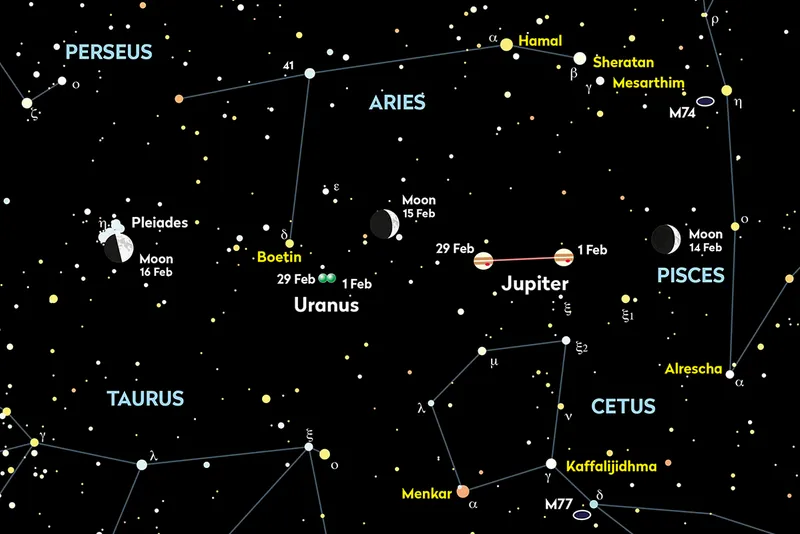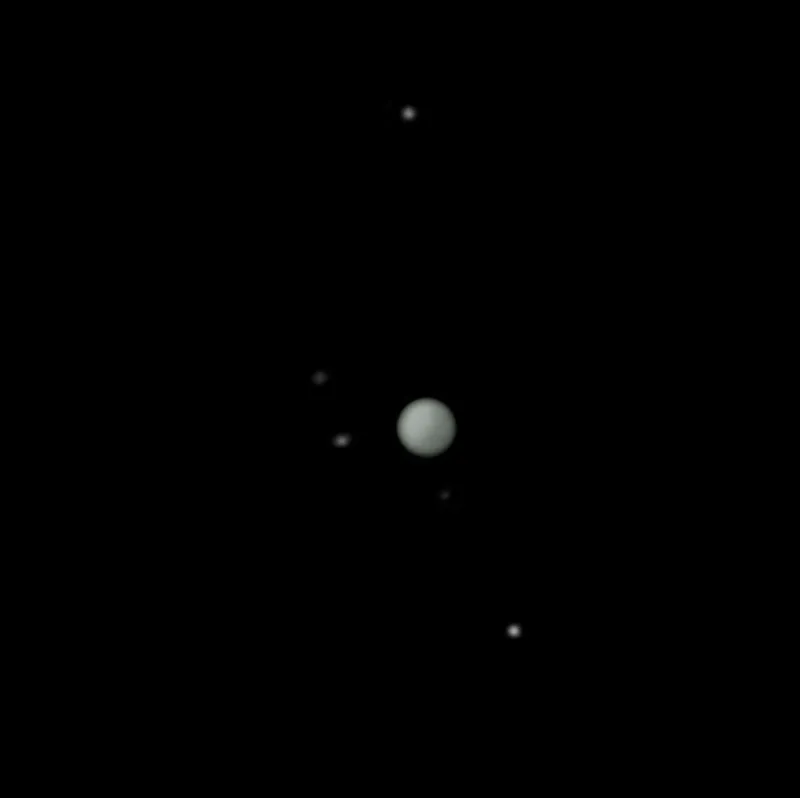There’s no hiding the fact that the planets are struggling currently.
The situation for all of the main planets is poor during the first half of 2024, with them either lost in the Sun’s glare or so low in the morning sky as to be unobservable.
Don’t despair though, because their return in the last half of the year will be rather spectacular.
The expanding evening twilight combined with Uranus’s daily westward drift catches up with this distant planet during February.
Throughout the month it loses its ability to reach its highest altitude of 54° up when due south under truly dark conditions.
For weekly stargazing advice delivered directly to your email inbox, sign up to receive the BBC Sky at Night Magazine e-newsletter.

On 1 February, true astronomical darkness arrives, with Uranus slightly to the west of south. Here, it is at its peak altitude and well positioned for observation.
But every day that passes chips away at this impressive altitude, so that by the end of February Uranus is 40° under dark skies.
To be fair, this isn’t bad at all, and an early evening observing period will still allow you to get the best out of Uranus.
Being such a distant world, it’s hard to see much in the way of detail.

A small scope will show its tiny 3-arcsecond disc and its rather striking greenish hue, something that’s not possible to see using binoculars, which reveal it to be exactly like a mag. 5.8 star.
On 15 February, a 42%-lit waxing crescent Moon sits 3° northwest of mag. 5.8 Uranus at 22:30 UT.
Currently Jupiter is also close to Uranus, the mag. –2.0 gas giant located 8.3° further to the west.
If the weather is kind, grab your final views of both Uranus and Jupiter this month as the twilight will rush up to meet them during March!
How to see the planets in February 2024

Uranus
- Best time to see: 1 February, 18:50 UT
- Altitude: 54°
- Location: Aries
- Direction: South
- Features: Colour, atmospheric banding through larger scopes, moons
- Recommended equipment: 200mm scope or larger
Mercury
- Best time to see: 1 February, 20 minutes before sunrise
- Altitude: 1.3° (extremely low)
- Location: Sagittarius
- Direction: Southeast
Not easily visible this month. A morning planet heading back towards the Sun on the southern side of the ecliptic, it has a very low altitude at sunrise that makes it difficult to see. Superior conjunction occurs on 28 February.
Venus
- Best time to see: 1 February, from 1 hour before sunrise
- Altitude: 3° (very low)
- Location: Sagittarius
- Direction: Southeast
At the start of February, mag. –3.9 Venus rises 100 minutes before the Sun, best seen around 07:00 UT, low over the southeast horizon. On 7 February, a very low 10%-lit waning crescent Moon sits 9.3° southwest. As the month progresses, Venus’s position deteriorates.
On 22 February, it sits 0.6° from mag. +1.3 Mars – very tricky to see in the bright dawn sky. On 29 February, now at mag. –3.8, Venus rises just 40 minutes before the Sun. Through a telescope, Venus appears 85% lit and 12 arcseconds across on 1 February. By 29 February, the phase increases to 91%, appearing fractionally smaller at 11 arcseconds across.
Mars
- Best time to see: 1 February, 30 minutes before sunrise
- Altitude: 1.2° (extremely low)
- Location: Aries
- Direction: Southeast
Morning planet Mars is too low, too dim and too close to the Sun to be seen properly this month. On 22 February, if you have a very flat southeast horizon, you might be able to spot the mag. +1.3 planet 0.6° from mag. –3.8 Venus, but the bright dawn twilight won’t make it easy.
Jupiter
- Best time to see: 1 February, 17:45 UT
- Altitude: 50°
- Location: Aries
- Direction: South
Jupiter appears as a mag. –2.2 jewel in the evening sky. At the start of February, it’s close to its highest position 50° up when due south as darkness falls, but by the end of the month it’s off to the west of south, only appearing 40° up as true darkness arrives.
The waxing crescent Moon pays Jupiter a visit on the evenings of 14 and 15 February.
Saturn
- Best time to see: 1 February, 18:00 UT
- Altitude: 8° (low)
- Location: Aquarius
- Direction: West-southwest
Saturn is now too low in the evening sky after sunset to be seen properly. Solar conjunction occurs on 28 February when, incidentally, Saturn lies 11 arcminutes from Mercury but too close to the Sun to be seen.
Neptune
- Best time to see: 1 February, 18:50 UT
- Altitude: 18°
- Location: Pisces
- Direction: West-southwest
Located near mag. +5.5 star 20 Piscium, evening planet Neptune’s time is limited as the evening twilight rushes up to engulf it. By the end of the month it’s unable to be seen under dark-sky conditions.
This guide originally appeared in the February 2024 issue of BBC Sky at Night Magazine.
